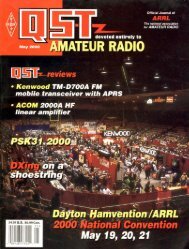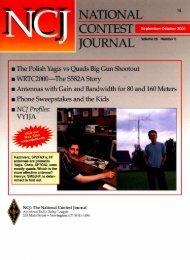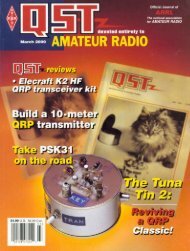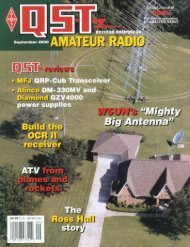Create successful ePaper yourself
Turn your PDF publications into a flip-book with our unique Google optimized e-Paper software.
Many of the HSCW web sites have a few<br />
sample pings that can be downloaded to see<br />
what the different speeds and strengths are<br />
like. After a few minutes spent playing with<br />
the program and learning the main<br />
functions, further “practice” is of little<br />
value. Now it’s time to join the HSCW<br />
Reflector and request a sked. (The meteorscatter<br />
reflector is often used in Europe.)<br />
What can you expect This depends<br />
upon your location, equipment, distance to<br />
the other station, the other op’s equipment,<br />
the time of year, the time of day—and<br />
maybe what your dog had for breakfast! For<br />
two small- or medium-size stations at an<br />
appropriate distance, ping rates may vary<br />
from only a few during any half-hour period<br />
to as many as 20 pings per minute.<br />
Conditions can vary greatly.<br />
Does it work The Europeans knock our<br />
socks off when it comes to routine MS<br />
QSOs. Also, Europe has many more active<br />
HSCW stations The biggest disadvantage<br />
to HSCW in the Western Hemisphere is the<br />
lack of stations—there just aren’t enough<br />
stations using this mode.<br />
Tips and Tricks<br />
Once you start running HSCW<br />
schedules, you may immediately notice<br />
how radically the number of pings varies<br />
from month to month, day to day and even<br />
minute to minute. The best time of year<br />
for sporadic meteors is July to January, with<br />
February to May being the poorest. HSCW<br />
will allow you to complete contacts on<br />
almost any day of the year, although certain<br />
periods will likely be easier than others.<br />
The number of sporadic meteors reaches<br />
a maximum at about 6 AM local time because<br />
the morning side of the earth is facing toward<br />
the direction of its orbital travel, sweeping<br />
up even slow-moving meteors. Around 6 PM<br />
local time, your location is on the trailing<br />
side, so only those meteors fast enough to<br />
overtake the earth will be captured (this is<br />
why MS is much easier in the morning).<br />
Meteor showers may be an exception—as<br />
long as the radiant is above your horizon. For<br />
information on daylight meteor showers, see<br />
the listings on listings the HSCW/MS “Hot<br />
News” Web page. 19<br />
On 144 MHz, one-second pings are<br />
excep-tional. Most pings are shorter than<br />
this, and many are much shorter. Because<br />
HSCW requires pings of at least a tenth of<br />
a second at 10,000 WPM (<strong>2000</strong> WPM),<br />
only a fraction of the total pings are likely<br />
to contain usable information.<br />
Other interesting things to watch for are<br />
Doppler shift, doubles, ionospheric scatter<br />
and—who knows Doppler shift isn’t often<br />
observed on underdense pings, but if you<br />
observe Doppler effects on one ping you’re<br />
more likely to see them on other pings.<br />
Another phenomenon you may notice<br />
32 <strong>November</strong> <strong>2000</strong><br />
Val, WD8KVD, operating W8WN’s rig in<br />
Kentucky in December 1997. This was her<br />
highest-speed-ever contact with KO0U.<br />
(especially during certain showers) is that<br />
pings seem to sometimes come in pairs. At<br />
first glance, this would appear to mean that<br />
some meteors are traveling together,<br />
separated by a second or so. Scientists have<br />
long contended that this is only a statistical<br />
fluke, but hams have noticed the phenomenon<br />
for many years, and visual observers<br />
have recently been reporting it. (It will be<br />
interesting to see what ideas the predictions<br />
of Asher and McNaught eventually bring<br />
to this idea. 20 )<br />
Finally, traces of ionospheric scatter are<br />
sometimes observed when two EME-class<br />
stations are running HSCW schedules. So<br />
when you’re doing this type of operating,<br />
remember to be alert for unusual occurrences!<br />
HSCW MS is much easier than other<br />
types of MS operation and has the advantage<br />
of visually displaying the pings, which<br />
makes it easier to carry out other observations.<br />
MSDSP also gives you the ability<br />
to save particularly interesting pings for later<br />
study. (If it all becomes too easy and you<br />
want a real challenge, see Maj. O. R.<br />
Disaster’s collection of the works of that<br />
great wireless pioneer, Owa Taboo Byam. 21 )<br />
Conclusion<br />
If you’re serious about VHF DX, you<br />
almost certainly have a multimode rig with<br />
an amplifier, a decent antenna and a computer.<br />
Don’t let the “CW” in the HSCW scare you<br />
away. You can slow the received signal down<br />
to any reasonable speed. At least try HSCW<br />
MS. If you’re an active VHF DXer already,<br />
you may be pleasantly surprised!<br />
Acknowledgements<br />
Thanks to everyone who helped me with<br />
this article and to those who helped get HSCW<br />
MS started here in the states. Special thanks<br />
go to my wife Lora, WD8LPN; to Val,<br />
WD8KVD; to Steve and Alisca for the use of<br />
their homes when operating portable in<br />
Minnesota and Michigan; to Steve Harrison,<br />
K0XP, for three years of schedules while we<br />
tested all of the things listed above; to Maarten,<br />
W1FIG, and Joe, K1JT; to the MSDSP Alphatest<br />
group for all of its work with the many<br />
versions of 9A4GL’s program; to Ilkka,<br />
OH5IY, whose multi-part MS-Soft program is<br />
used by nearly every MS operator around the<br />
world; to Peter, DL3JIN, and Tihomir, 9A4GL,<br />
whose programming abilities and hard work<br />
started the modern age of HSCW operation;<br />
and to those HSCW operators in North<br />
America and Europe who have helped with<br />
testing, ideas and operating suggestions.<br />
Notes<br />
1<br />
Rick Lindquist, N1RL, “VHF-UHF Pioneer<br />
Paul M. Wilson, W4HHK, SK,” Happenings,<br />
<strong>QST</strong>, Feb <strong>2000</strong>, p 75.<br />
2 Emil Pocock, W3EP, ed., Beyond Line of<br />
Sight, pp 95-96. (A book of classic propagation<br />
reprints for the VHF DXer, available<br />
from the ARRL.)<br />
3 Emil Pocock, ed., Beyond Line of Sight, pp<br />
104-105.<br />
4 Walter F. Bain, W4LTU, “V. H. F. Meteor<br />
Scatter Propagation,” <strong>QST</strong>, April 1957, pp<br />
20-24, 140, 142, 144.<br />
5<br />
Walter F. Bain, W4LTU, “VHF Propagation<br />
by Meteor-Trail Ionization,” <strong>QST</strong>, May 1974,<br />
pp 41-47, 176. Reprinted in Beyond Line of<br />
Sight, pp 108-115.<br />
6<br />
See the sidebar, “HSCW Meteor Scatter<br />
Records are Made to be Broken,” on page<br />
38 of Apr 1998 <strong>QST</strong>.<br />
7 http://www.qsl.net/w8wn/wd8kvd/<br />
wd8kvd2.html.<br />
8 http://www.qsl.net/w8wn/hscw/papers/<br />
archive.html#w8wn/k0xp.<br />
9 See the North American “Procedures” paper,<br />
available on most of the HSCW Web sites,<br />
for more. (The Region I procedures can be<br />
found at http://www.scit.wlv.uk/vhfc/<br />
iaru.r1.vhfm.4e/5B.html.)<br />
10<br />
http://www.dxworld.com/hsms.html.<br />
11 To join, send a message to “Majordomo@<br />
qth.net” with “subscribe hsms” as the text.<br />
12 Start with the W6/PA0ZN Main NA HSCW<br />
Web Site at http://www.nitehawk.com/<br />
rasmit/ws1_15.html, or the HSCW section<br />
of W8WN’s Web site at http://www.qsl.net/<br />
w8wn/. Both have many links to other sites.<br />
13<br />
For a discussion of keying methods, see The<br />
FCC Rule Book, available from the ARRL.<br />
See the publications ad in this issue.<br />
14 Jim McMasters, KD5BUR “High-Speed CW<br />
and Meteor Scatter - An Exciting VHF DX<br />
Medium!,” <strong>QST</strong>, April 1998, pp 34-39.<br />
15<br />
Kenneth Davies, Ionospheric Radio Propagation,<br />
U.S. Dept. of Commerce, 1965, pp<br />
351-376.<br />
16 See the text files bundled with OH5MS’s<br />
“MS-Soft” meteor program, available at<br />
http://www.sci.fi/~oh5iy/.<br />
17<br />
WinMSDSP is available at http://ham2.<br />
irb.hr/9a4gl/index.php3 or VE5EF’s mirror<br />
site, http:// www3.sk.sympatico.ca/freed/<br />
projects/9A4GL. It and other HSCW material<br />
are also available at the W8WN Web<br />
site.<br />
18<br />
See http://www.qsl.net/w8wn/.<br />
19 http://www.qsl.net/w8wn/hscw/papers/<br />
hot_news.html. Much more also on the<br />
“Archived News” page.<br />
20<br />
See several articles in Sky and Telescope,<br />
June <strong>2000</strong>, pp 30-40. A brief summary of<br />
their predictions is also available at http://<br />
www.qsl.net/w8wn/hscw/prop/<br />
leodust.html.<br />
21 http://www.qsl.net/w8wn/hscw/papers/<br />
lose-qso.html.<br />
You can contact the author at 465<br />
Springfield Rd, Elizabethtown, KY 42701;<br />
w8wn@arrl.net.

















